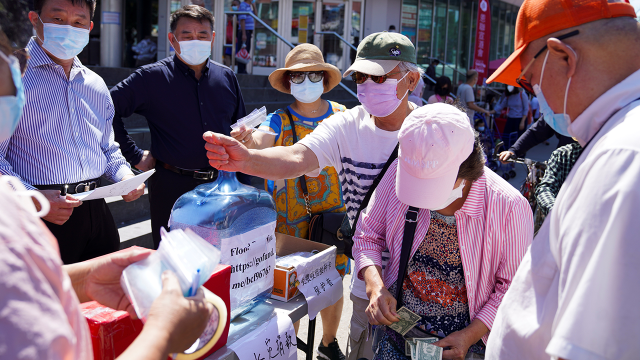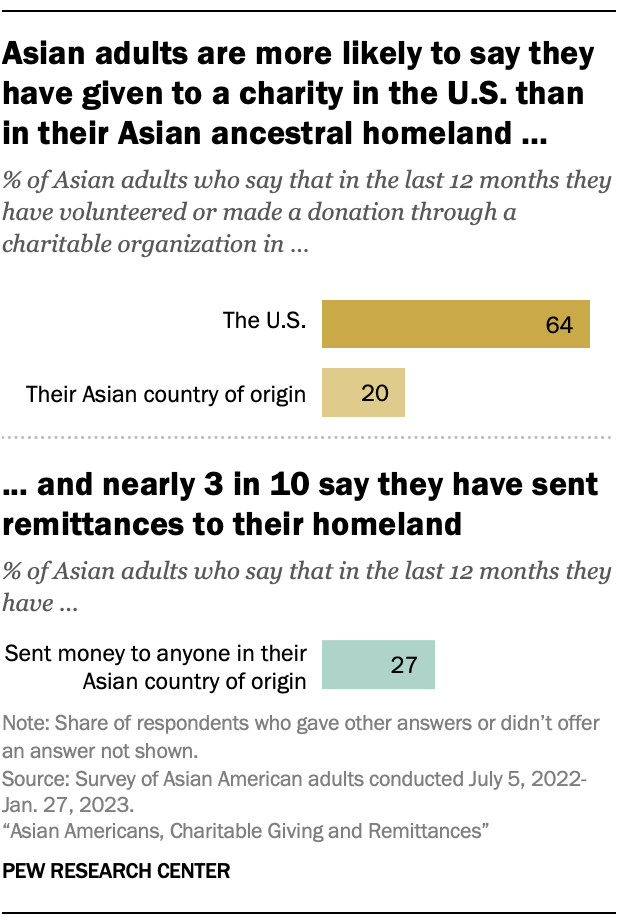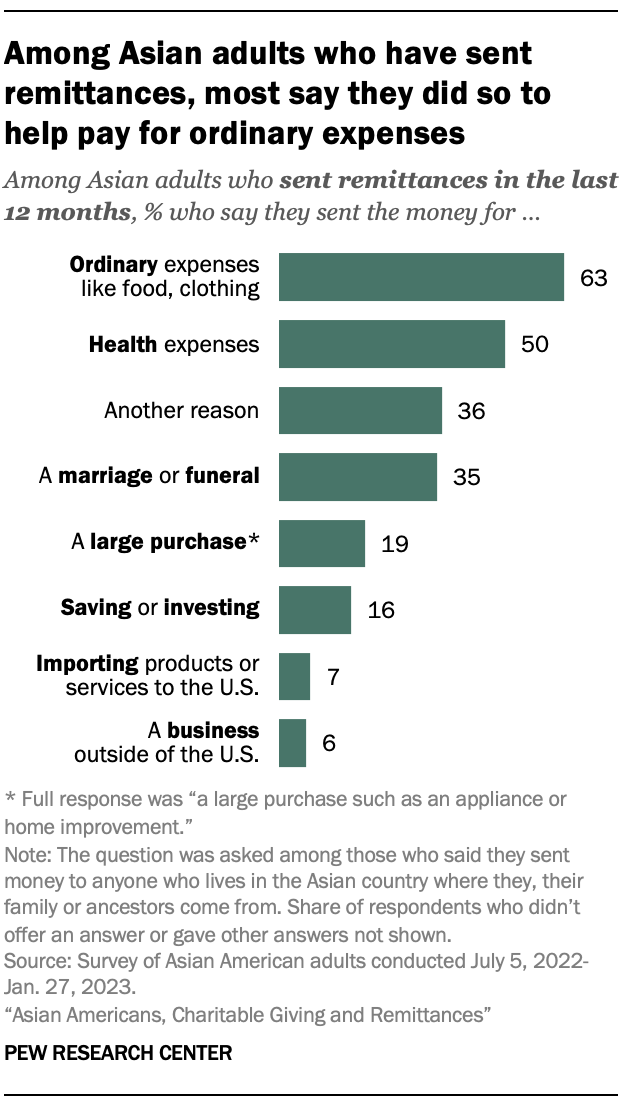Most Asian Americans have given to U.S. charities; smaller shares have given to charities in their ancestral homelands or have sent money there through remittances

The terms Asians, Asians living in the United States, U.S. Asian population and Asian Americans are used interchangeably throughout this report to refer to U.S. adults who self-identify as Asian, either alone or in combination with other races or Hispanic identity.
Asian origins and origin group labels, such as Chinese and Chinese origin, are used interchangeably in this report for findings for Asian origin groups, such as Chinese, Filipino, Indian, Japanese, Korean or Vietnamese. Origin groups in this report include those who report being one Asian origin only, either alone or in combination with a non-Asian race or ethnicity. For this report, Chinese adults do not include those who self-identify as Taiwanese.
Immigrants in this report are people who were born outside the 50 U.S. states or the District of Columbia, Puerto Rico or other U.S. territories. Immigrant and foreign born are used interchangeably to refer to this group.
U.S. born refers to people born in the 50 U.S. states or the District of Columbia, Puerto Rico or other U.S. territories.
Second generation refers to people born in the 50 states or the District of Columbia, Puerto Rico or other U.S. territories with at least one foreign-born (immigrant) parent.
Third or higher generation refers to people born in the 50 states or the District of Columbia, Puerto Rico or other U.S. territories with both parents born in the 50 states, D.C., Puerto Rico or other U.S. territories.
Ancestral homeland is used in this report to refer to the country in Asia that respondents trace their ancestry or heritage to, including the country they are from or the country their family or ancestors are from. It is used interchangeably with Asian country of origin and place of origin throughout this report.
In this report, charitable giving refers to whether respondents say they volunteered or made a donation through a charitable organization. While the survey captures whether Asian Americans donated or volunteered time to charities in the prior 12 months, it does not capture how much time or money or to which organizations they donated.
Remittances are personal financial transfers that many immigrants, or people from immigrant families, send to someone living in the place or country where they, their family or ancestors are from. The survey asks whether Asian Americans have sent money to anyone who lives in their Asian ancestral homeland in the prior 12 months. Data from the World Bank provides estimates on how much money was sent, globally and from people living in the U.S., in 2021.
Pew Research Center conducted this analysis to understand Asian Americans’ ties to their countries of origin through charitable giving and remittances. This report is part of the Center’s in-depth analysis of public opinion among Asian Americans.
The data in this report comes from a nationally representative survey of 7,006 Asian adults exploring the experiences, attitudes and views of Asians living in the U.S. on several topics, including charitable giving and remittances, identity, affirmative action, global affairs, policy priorities, religious identities, discrimination and racism in America, and living with economic hardship. The survey sampled U.S. adults who self-identify as Asian, either alone or in combination with other races or Hispanic ethnicity. It was offered in six languages: Chinese (Simplified and Traditional), English, Hindi, Korean, Tagalog and Vietnamese. Responses were collected from July 5, 2022, to Jan. 27, 2023, by Westat on behalf of Pew Research Center.
The Center recruited a large sample to examine the diversity of the U.S. Asian population, with oversamples of the Chinese, Filipino, Indian, Korean and Vietnamese populations. These are the five largest origin groups among Asian Americans. The survey also includes a large enough sample of self-identified Japanese adults, making findings about them reportable. In this report, the six largest origin groups include those who identify with one Asian origin only, either alone or in combination with a non-Asian race or ethnicity. These are the six origin groups whose attitudes and opinions are highlighted throughout the report.
Survey respondents were drawn from a national sample of residential mailing addresses, which included addresses from all 50 states and the District of Columbia. Specialized surname list frames maintained by the Marketing Systems Group were used to supplement the sample. Those eligible to complete the survey were offered the opportunity to do so online or by mail with a paper questionnaire. For more details, refer to the methodology. For questions used in this analysis, refer to the topline questionnaire.
Findings for less populous Asian origin groups in the U.S., those who are not among the six largest Asian origin groups, are grouped under the category “other” and are included in the overall Asian adult findings in the report. These ethnic origin groups each make up about 2% or less of the Asian population in the U.S., making it challenging to recruit nationally representative samples for each origin group. The group “other” includes those who identify with one Asian origin only, either alone or in combination with a non-Asian race or Hispanic ethnicity. Findings for those who identify with two or more Asian origins are not presented by themselves in this report but are included in the overall Asian adult findings.
The analysis of remittance flows and origin countries’ gross domestic product uses data from the World Bank’s Bilateral Remittance Matrix and national accounts data. The World Bank’s global remittance estimates are based on a set of estimates about the size of the global migrant stock, as well as other information, such as incomes in migrants’ destination countries.
Pew Research Center is a subsidiary of The Pew Charitable Trusts, its primary funder. The Center’s Asian American portfolio was funded by The Pew Charitable Trusts, with generous support from The Asian American Foundation; Chan Zuckerberg Initiative DAF, an advised fund of the Silicon Valley Community Foundation; the Robert Wood Johnson Foundation; the Henry Luce Foundation; the Doris Duke Foundation; The Wallace H. Coulter Foundation; The Dirk and Charlene Kabcenell Foundation; The Long Family Foundation; Lu-Hebert Fund; Gee Family Foundation; Joseph Cotchett; the Julian Abdey and Sabrina Moyle Charitable Fund; and Nanci Nishimura.
We would also like to thank the Leaders Forum for its thought leadership and valuable assistance in helping make this survey possible.
The strategic communications campaign used to promote the research was made possible with generous support from the Doris Duke Foundation.
Asian Americans are the only major racial or ethnic group in the United States that is majority immigrant. Many Asian Americans either grew up or spent considerable time in their Asian ancestral homeland, and many have immediate family members who still live there today.

Amid these personal and family connections between Asian Americans and their ancestral homelands, we wanted to understand the financial and philanthropic ties they have to both the U.S. and their Asian origin countries.
Overall, 64% of Asian adults say they have given to a charitable organization in the U.S. in the last 12 months, according to a new analysis of a multilingual, nationally representative survey of 7,006 Asian American adults conducted July 5, 2022, through Jan. 27, 2023.
Meanwhile, 20% of Asian adults in the U.S. say they have given to a charity located in their Asian country of origin in the 12 months before the survey. And 27% say they have sent money to someone living there – personal financial transfers known as remittances.
In 2022, immigrants made up 54% of all Asian Americans and 67% of Asian American adults, according to a Pew Research Center analysis of the 2022 American Community Survey.1 In our survey, 54% of Asian adults report having immediate family members still living in their Asian origin country.
Among the survey’s other key findings:
- Most Asian adults (67%) have given to a charitable organization in the U.S., their Asian country of origin or both places. Overall, they are about three times more likely to say they have volunteered or made a donation through a charity in the U.S. than one in their Asian origin country in the 12 months before the survey (64% vs. 20%).
- Regardless of whether Asian adults are immigrants or born in the U.S., most have given to a U.S. charity. More than 60% of each group say they have done so. However, immigrants are more likely than U.S.-born Asian adults to say they have given to a charity in their Asian country of origin (23% vs. 11%).

- Whether Asian Americans have given to charitable organizations is associated with how important religion is in their life. Asian adults who say religion is very important in their life are more likely than those who say it is not too or not at all important to have given to a charity in either of the places asked about.
- Filipino, Indian and Vietnamese adults in the U.S. are more likely than other Asian origin groups to say they have sent remittances in the 12 months before the survey. Chinese and Japanese adults in the U.S. are among the least likely to say so.
- Among Asian adults who have sent remittances, the most common reasons for doing so are to help with ordinary expenses (63%) and health expenses (50%). Reasons vary somewhat across Asian origin groups, education and family ties to one’s ancestral homeland.
- In 2021, Asian Americans’ places of origin collectively received about $63 billion in remittances from the U.S. Among the biggest recipients were the six most common origin countries for Asian Americans – India, the Philippines, China, Vietnam, South Korea and Japan – which received about $55 billion of these remittances, according to our analysis of World Bank data.
The following chapters look more closely at:




